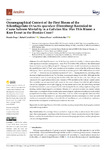Mostrar o rexistro simple do ítem
Oceanographical Context of the First Bloom of the Silicoflagellate Octactis speculum (Ehrenberg) Recorded to Cause Salmon Mortality in a Galician Ria: Was This Bloom a Rare Event in the Iberian Coast?
| dc.contributor.author | Prego, Ricardo | |
| dc.contributor.author | Carballeira, Rafael | |
| dc.contributor.author | Pazos, Yolanda | |
| dc.contributor.author | Bao, Roberto | |
| dc.date.accessioned | 2024-03-07T20:16:35Z | |
| dc.date.available | 2024-03-07T20:16:35Z | |
| dc.date.issued | 2023-07-02 | |
| dc.identifier.citation | Prego, R.; Carballeira, R.; Pazos, Y.; Bao, R. Oceanographical Context of the First Bloom of the Silicoflagellate Octactis speculum (Ehrenberg) Recorded to Cause Salmon Mortality in a Galician Ria: Was This Bloom a Rare Event in the Iberian Coast? Toxins 2023, 15, 435. https://doi.org/10.3390/toxins15070435 | es_ES |
| dc.identifier.issn | 2072-6651 | |
| dc.identifier.uri | http://hdl.handle.net/2183/35813 | |
| dc.description | This article belongs to the Special Issue Harmful Algal Blooms and Microalgae from Ecology to Control Strategies | es_ES |
| dc.description.abstract | [Abstract] Harmful algal blooms are one of the leading causes of mortality in salmon aquaculture, with significant economic consequences. From 15 to 31 October 1996, a bloom of the skeletonized form of Octactis speculum (Ehrenberg) F.H. Chang, J.M. Grieve & J.E. Sutherland was detected in the small Merexo inlet (1.7 km2 area), located on the southern shore of the Ria of Muxía (Galicia, NW Spain). The O. speculum population inside the inlet (data period: 1992–1996) seldom exceeded 4·103 cell·L−1. However, its concentration reached 2·105 cell·L−1 during the bloom, coinciding with a decrease in light penetration from 5 to 2 m deep, as measured using a Secchi disk. Although similar concentrations were reported during late October 1992, this was the first time that a bloom was associated with caged salmon (Salmo salar, Linnaeus 1758) mortality in the Galician coastal waters. This mortality was not associated with anoxia in the water column, but with fish gill irritations and mucus segregation due to gill clogging. Excess nitrate and silicate, the latter being essential for skeleton formation, were measured in the inlet during the bloom, with phosphate acting as the limiting nutrient (high negative correlation). Blooms of O. speculum occurred in autumn–winter, when water was retained within the inlet under meteorological conditions of southwest winds (which prompted downwelling conditions) and clear skies. A review of the oceanographic database of the Galician rias showed that massive O. speculum proliferations are also commonplace in other rias with similar environmental conditions, such as the Ria of Ares-Betanzos, and can therefore constitute a threat for the development of salmon aquaculture on this coast. | es_ES |
| dc.description.sponsorship | This research was funded by the Consolidation and Structuring of Competitive Research Group Océano of the Xunta de Galicia, grant number IN607A2021/04. R.C. was supported by a Juan de la Cierva contract (FJC-2021-046415-I) of the Spanish Ministry of Science and Innovation financed by the Next Generation EU | es_ES |
| dc.description.sponsorship | Xunta de Galicia; IN607A2021/04 | es_ES |
| dc.language.iso | eng | es_ES |
| dc.publisher | MDPI | es_ES |
| dc.relation | info:eu-repo/grantAgreement/AEI/Plan Estatal de Investigación Científica y Técnica y de Innovación 2021-2023/FJC2021-046415-I/ES/ | es_ES |
| dc.relation.uri | https://doi.org/10.3390/toxins15070435 | es_ES |
| dc.rights | Atribución 4.0 Internacional | es_ES |
| dc.rights.uri | http://creativecommons.org/licenses/by/4.0/ | * |
| dc.subject | Harmful algal blooms | es_ES |
| dc.subject | HAB | es_ES |
| dc.subject | Fish mortality | es_ES |
| dc.subject | Marine phytoplankton | es_ES |
| dc.subject | Hydrography | es_ES |
| dc.subject | Nutrient salts | es_ES |
| dc.subject | Salmon aquaculture | es_ES |
| dc.title | Oceanographical Context of the First Bloom of the Silicoflagellate Octactis speculum (Ehrenberg) Recorded to Cause Salmon Mortality in a Galician Ria: Was This Bloom a Rare Event in the Iberian Coast? | es_ES |
| dc.type | info:eu-repo/semantics/article | es_ES |
| dc.rights.access | info:eu-repo/semantics/openAccess | es_ES |
| UDC.journalTitle | Toxins | es_ES |
| UDC.volume | 15 (2023) | es_ES |
| UDC.issue | 7 | es_ES |
| UDC.startPage | 435 | es_ES |
| dc.identifier.doi | 10.3390/toxins15070435 |
Ficheiros no ítem
Este ítem aparece na(s) seguinte(s) colección(s)
-
GI-GRICA - Artigos [49]






